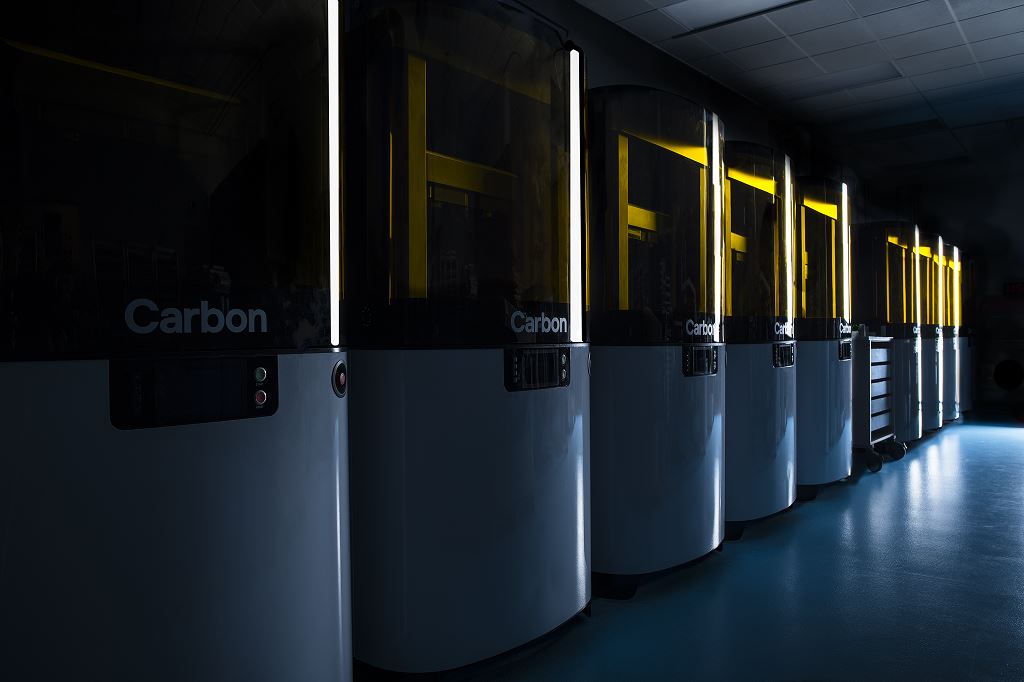![L1 systems set up in a Carbon lab [Image: Carbon]](https://fabbaloo.com/wp-content/uploads/2020/05/Carbon2BL1s2BLab1_img_5eb0952a23067.jpg)
With more than $260 million just announced in a growth funding round, Carbon has now raised more than $680 million — bringing their valuation to $2.4 billion.
We were impressed when funding was nearing half a billion dollars just a year and a half ago, when a $200M Series D funding round brought the total up to $422M. We wondered, just a few months ago, what would happen if Carbon pulled in another $300 million. Now they’re answering that question (plus or minus a few million $$).
The new round was co-led by Madrone Capital Partners and Baillie Gifford, along with investors new (Temasek and Arkema) and existing (Sequoia Capital, JJDC, Fidelity Management & Research Company, adidas Ventures, JSR Corporation), totalling to that new $680M fundraising total.
Carbon says the post-money valuation is now $2.4 billion. The company reached unicorn ($1B valuation) status in 2015. At an estimated $2.4B now, it’s squarely at the head of even the unicorn pack. Both the valuation and the total funding are massive, leading the way for 3D printing companies.
Funding Plans
And the plans for the latest financial influx are, unsurprisingly, many.
R&D expansion is the biggest focus, as the company is planning an Advanced Development Facility (ADF) “to improve Carbon’s platform and workflows”, and to focus on expansion in the European and Asian markets. These shouldn’t be much of a surprise, as such facilities offer valuable space for dedicated R&D, and we’re seeing more companies create more spaces for 3D printing-specific initiatives to develop, often working closely with partners in these on-site labs. International expansion as well is picking up steadily across the 3D printing industry, as more processes cross the ocean for more installations with more support.
Materials and software development will also get a boost. For the former, recyclable and biocompatible materials are in sight. For the latter, the Digital Manufacturing Cloud and other software capabilities will continue to evolve. The company notes:
“Carbon’s software objectives will emphasize automated design tools focused on algorithmic lattice generation, as well as improved digital factory workflow, including fleet monitoring, quality control, and compliance information management. As part of this expansion, Carbon will continue developing and improving the automation, monitoring, and analytics software that enables large-scale production on the Carbon Platform.”
Again, all of these plans fit in precisely where the market is focusing today — for a smoother workflow tomorrow. The technologies of Industry 4.0 rely on a connected workflow, and better automation with reliable materials will ensure that Carbon’s Digital Light Synthesis continues to fit neatly into digital manufacturing workflows.
Carbon’s Progress
Carbon sees applications for its DLS offerings across a variety of industries: from automotive to healthcare and dentistry to athletics to consumer goods. Many of their most successful forays in these are quite public, as the company has become quite fond of partnering with big names in each of these fields: think Ford, J&J (which is also an investor), Riddell, adidas.
Altogether, these are painting a big picture for this big company: large-scale 3D printing is viable in manufacturing. Carbon’s most recent 3D printer introduction was a not-so-subtle reminder of this, as the L1 is made for large things.
Over the last six years since its founding — also friendly reminder that all of this has been accomplished only since 2013 — Carbon has grown to a team of more than 400. And counting: the new funding has team expansion in view, as well, with growth planned in sales, marketing, and customer experience.
They’ll need the support, especially with the international growth; the company notes that the Carbon Platform is operational in 14 countries and “has seen a 33X increase in print volumes over the past 12 months and more than a 5X increase in print hours.”
What’s Next?
Carbon has laid its cards on the table so far as the funding goes, as well as immediate plans in place to propel to the next phases of growth across a few key areas. But that doesn’t mean we’re not left wondering what will come next from the California-based company.
Will they enter new markets? New applications? Will they announce more partners with familiar names? Will they — gasp — go public?
Only time will tell, but whatever the next step from Carbon is, we can be sure of one thing: it’s going to have an impact on the broader picture of the evolving digital manufacturing environment.
Via Carbon











Tech Soft 3D, a producer of powerful toolkits for CAD/CAM applications, received significant funding.